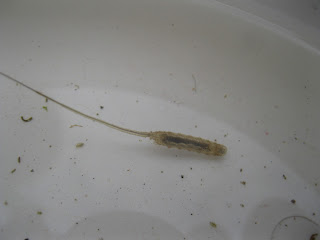|
Yesterday the kids were busy pond dipping and my daughter suddenley shouted me over to look at a creature they had never seen before. Kids being kids, you often get asked to look at something barely worth the effort. But on this occasion, what they had found immediately grabbed my attention. Even though we only completed the pond a matter of weeks ago, we already have a varied amount of pond species, but nothing like the one found by my daughter. |
| If I had to describe it, I would say it resembled a caterpillar with a long pointed tail. So with photos taken, I headed back into the house to jump onto the interent to do a bit a research. I have found a really good pond creature identification website, called Microscopy UK, which I have found very usefull in the identification of the more uncommon creatures in our wildlife pond. The site, breaks down the different creature categories into seperate sections making it much easier to discover what you have in your pond. |
|
Here are a few photos of the creature in question : At first glance I assumed the creature to be a type of worm, but by using the Microscopy-UK.org.uk site identification kit, I used the different category diagrams and descriptions to eliminate worm from my query. It turned out that the creature was a type of fly larva aptley named the rat-tailed maggot. Which would then grow into a Eristalis tenax, or simply and much easier to remember, a Drone Fly. The Drone fly is a type of European Hoverfly and thinking back we have all noticed several hover flies spending a lot of time around the pond, sun bathing on the rocks and walking around on the lilly pads. |
|
It will be interesting to see how this new addition develops and is a welcome visitor to our wildlife pond. The pond is becoming a real attraction for the kids (And myself) and is a great way for them to learn about nature. I am already confident that if we went on a walk in a local park and found a pond, they would be able to identify a number of different species. Well the pond is going from strength to strength and we look forward to making new discoveries, so watch this space... |











